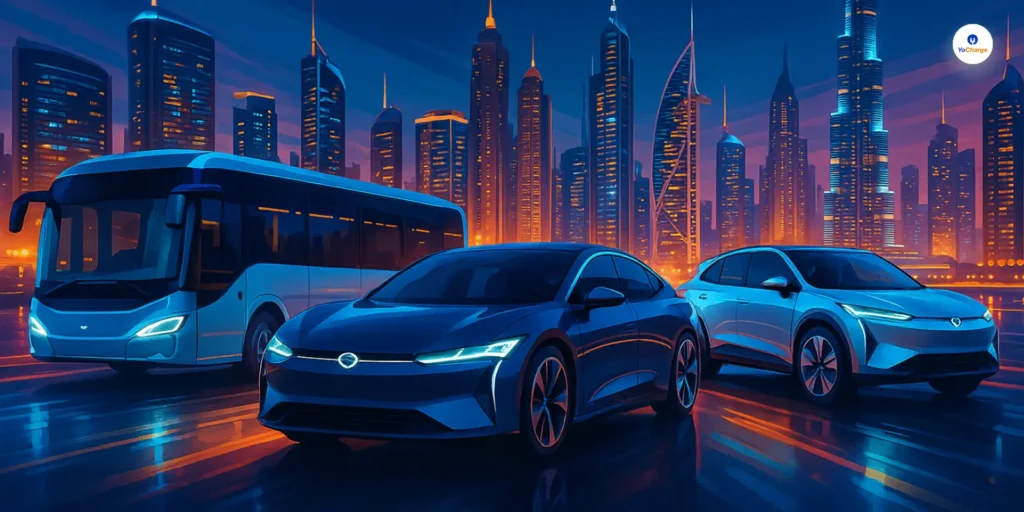
Advancement in Electric Motor Design: Electric vehicles (EVs) are changing the way we think about transportation. They use electric motors instead of gasoline engines. These motors are essential because they convert electricity into movement. As technology improves, so do electric motors.
This article will explore the advanced electric motor design used in EVs. We will look at different types of motors and how they work. We will also discuss the latest technology that makes these motors even better.
Key Innovations in Electric Motor Design
The electric vehicle motor design has come a long way. Engineers are always looking for ways to make them more efficient, lighter, and stronger. Here are some key innovations in electric motor design:
Permanent Magnet Synchronous Motors (PMSMs)
Permanent Magnet Synchronous Motors (PMSMs) are popular in electric vehicles. They use magnets to create a magnetic field. This helps the motor turn smoothly and efficiently. PMSMs are very powerful and can provide high torque at low speeds. This means they can get moving quickly, which is great for cars.
However, PMSMs often use rare materials for their magnets, like neodymium. These materials can be hard to find and expensive. Engineers are working to make these motors without relying on rare materials.
Induction Motors
Induction motors are another type of electric motor used in EVs. They work differently from PMSMs. Instead of using magnets, they create a magnetic field through electricity flowing in wire coils. This makes them simpler and cheaper to produce.
motors are very reliable and can handle tough conditions. They also do not require rare materials, making them a good choice for many manufacturers. Tesla uses induction motors in some of its models because they are efficient and durable.
Switched Reluctance Motors (SRMs)
Switched Reluctance Motors (SRMs) are gaining popularity too. They have a unique design that allows them to be very efficient. SRMs do not use permanent magnets at all! Instead, they rely on the magnetic reluctance of the rotor, which is the part that turns.
This design means SRMs can be made with common materials, making them less expensive than other motors. They can also operate at high temperatures without losing performance, which is important for electric vehicles that might overheat during use.
Axial Flux Motors
Axial Flux Motors is an exciting new design gaining attention in the EV world. Unlike traditional motors that have a radial design (where the magnetic field flows outward), axial flux motors have a flat shape where the magnetic field flows along the axis of the motor. This design allows for more power while being lighter than traditional motors.
Axial Flux Motors takes up less space and can fit better into vehicles, making them ideal for electric cars and motorcycles. Companies are exploring this technology to improve performance and efficiency.
Also Read: Flex Fuel Cars vs Electric Cars
Advances in Electric Motor Design Control Electronics
Electric motors need control systems to work effectively. These systems help manage how much power goes to the motor and how it responds to driver inputs. Recent advances in control technology make electric motors even better.
Advanced Inverter Technology
Inverters are devices that convert direct current (DC) from batteries into alternating current (AC) for electric motors. New inverter technology is making this process more efficient and faster.
Modern inverters can handle more power while being smaller in size. This means they can help improve the overall performance of electric vehicles by providing quicker acceleration and smoother driving experiences.
- Higher Efficiency: New inverter designs are more efficient at converting power, which means less energy is wasted as heat.
- Compact Size: Modern inverters are smaller and lighter, making them easier to integrate into vehicles without adding too much weight.
- Better Control: Advanced inverters can respond more quickly to changes in demand from the motor, improving overall performance.
Sophisticated Control Algorithms
Control algorithms are like the brains of the motor system. They tell the motor how to behave based on different driving conditions. Recent improvements in these algorithms allow for better performance.
For example, advanced algorithms can optimize energy use based on how fast you drive or how steep a hill is. This means drivers can get more range out of their batteries while still enjoying a powerful driving experience.
- Real-Time Adjustments: Sophisticated algorithms can analyze data from the motor and adjust operations instantly. This ensures optimal performance under different conditions.
- Enhanced Performance: By using complex calculations, these algorithms can fine-tune motor operation for maximum efficiency and responsiveness.
- Adaptability: Advanced algorithms allow motors to adapt to different driving scenarios, such as accelerating on a flat road or climbing a hill.
Advanced Pulse Width Modulation (PWM)
Pulse Width Modulation (PWM) is a technique used to control the speed and torque of electric motors. It works by turning the power supplied to the motor on and off very quickly. The length of time the power is on compared to when it is off determines the average power the motor receives. Here’s how it enhances motor performance:
- Precise Control: By adjusting the width of the pulses, engineers can fine-tune how much power goes to the motor. This allows for smooth acceleration and deceleration.
- Efficiency: PWM helps reduce energy waste. Instead of constantly supplying full power, it only provides what is needed at any moment.
- Less Heat: Because PWM controls power more effectively, it generates less heat in the motor, which can extend its life.
Vector Control
Vector Control is another advanced technique that improves motor performance. It allows for precise control of the magnetic field inside the motor. Here’s how it works:
- Magnetic Field Management: Vector Control continuously measures the rotor’s position and adjusts the magnetic field accordingly. This ensures that the motor operates at its best efficiency.
- High Performance: By controlling both torque and magnetic flux separately, Vector Control enables quick responses to changes in load or speed. This makes electric vehicles feel more responsive when driving.
- Applications: Many modern electric vehicles use Vector Control because it offers better speed regulation and torque performance, especially at low speeds.
Sensorless Control
Sensorless Control is an innovative approach that eliminates the need for physical sensors to determine the rotor’s position. Instead, it uses advanced algorithms to estimate this position based on other data. Here are its benefits:
- Cost Reduction: Without physical sensors, manufacturers can save on costs and reduce complexity in design.
- Simplicity: Sensorless systems are easier to install and maintain since they have fewer components.
- Reliability: Fewer parts mean fewer things can break down, leading to more reliable operation over time.
Also Read: 9 Electric Vehicle Myths
Conclusion
Advanced electric motor design plays a crucial role in making electric vehicles better every day. With innovations like Permanent Magnet Synchronous Motors, Induction Motors, Switched Reluctance Motors, and Axial Flux Motors, engineers are finding new ways to improve efficiency and power.
Additionally, advancements in inverter technology and control algorithms help these motors perform at their best while being lightweight and cost-effective.
As we continue to develop these technologies, electric vehicles will become more popular and accessible for everyone, leading us toward a cleaner and greener future!



